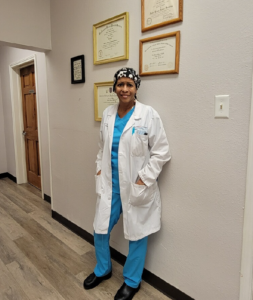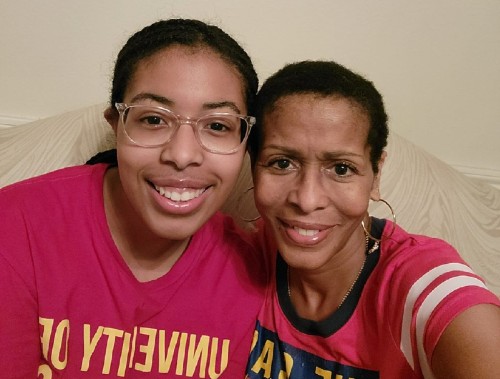When Tina Oliver had a sudden, severe headache, she knew she needed to get help fast.

When she blew her nose, she felt something pop. “It was like an explosion in my head,” she says. “It was big.” Two terrifying words came to mind: brain aneurysm. But the 60-year-old podiatrist couldn’t believe that was a real possibility. She was in good health. She’d never had any neurological issues. There was no family history of aneurysm.
“I was just in shock,” she recalls. “I was thinking, ‘It couldn’t be. It couldn’t be.’ ” She keeps a blood pressure cuff in her bedroom, and she put it on. Her blood pressure was sky-high. By then, she could feel the neck stiffness that she knew was a sign of a ruptured brain aneurysm. She was suddenly overwhelmed by nausea. She slid to the floor.
Her daughter, Martina, a freshman at the University of St. Thomas, was upstairs. Dr. Oliver called out to her and briefly explained what was happening. Then she dialed 911.
In the few minutes before the ambulance arrived, Martina comforted her older brother, who is on the autism spectrum. She was careful not to overwhelm him with the magnitude of the situation. She told him, “Mom has a bad headache. We’re going to take her to the hospital.”
Cerebral aneurysms are balloon-like protrusions that form at a weak spot on an artery in the brain. The National Institutes of Health estimates that between 3% and 5% of Americans may have an aneurysm in their lifetime. While they can happen to anyone at any time, they typically occur in adults between the ages of 30 and 60, and they’re more common in women than in men. About 30,000 Americans suffer a brain aneurysm rupture every year.
A sudden, severe headache is the most common symptom. Stiff neck, nausea, vomiting, sensitivity to light and double vision can also signal a rupture. Once the bleeding starts, however, time is of the essence.
“Depending on the severity, you may lose consciousness or have a seizure, or it may just be a bad headache,” says Arthur Day, MD, a physician affiliated with Memorial Hermann. “If you have a headache unlike any you’ve ever had before, get to the hospital.”
Getting immediate treatment can significantly improve a patient’s odds of survival, but the size of the aneurysm and the extent of the bleeding also play a part. About 25% of patients die within 24 hours of a rupture; another 25% die from complications shortly thereafter, according to the NIH. Some suffer permanent neurological damage, while others recover completely.
Martina rode with her mom in the ambulance to Memorial Hermann Pearland Hospital, where a scan confirmed what Dr. Oliver had suspected. She needed brain surgery, and she needed it quickly. She was transported to Memorial Hermann-Texas Medical Center, where doctors had two options for surgery: coil embolization or microvascular clipping. Each carries risks.
If an aneurysm is a balloon protruding from the side of an artery, when it ruptures the balloon pops, forming a hole through which blood can escape. The two treatment options are essentially to plug the hole or to tie the neck of the balloon. With the former method, surgeons thread a catheter into the femoral artery through the groin, sending it up the aorta and all the way into the brain, then into the aneurysm itself. They push a wire through the catheter that, when it comes out the other end, forms tight coils inside the aneurysm, blocking the hole. With the latter method, surgeons take a more direct approach: They open the skull and use a clothespin-like titanium clip to seal the aneurysm off at its point of origin on the artery.
“With the coil procedure, the risk is that it might perforate the aneurysm and make it bleed again. Since the work is done through the groin, it’s less invasive, but a certain percentage of aneurysms treated with the coil will reform later, so we have to watch them for several years afterward to make sure that doesn’t happen,” says Dr. Day. “When we open the head, it is more invasive, and we have to give you a haircut. But the benefit of the clip is that most of the time, the aneurysm is cured for life.”
Dr. Oliver’s team chose to use the clip procedure.
Assuming a patient survives the initial rupture, the week following a brain bleed is the most dangerous, even if the aneurysm has been successfully repaired. That’s because the leaked blood mixes with the spinal fluid surrounding the brain, where, over time, it starts to degrade and can irritate the brain’s arteries to the point that they begin to spasm.
“If that happens, it can block the blood going through the artery, causing a stroke,” says Dr. Day. “The peak of that danger is a week after the bleeding.”
Martina watched her mom carefully in the days following her seven-hour surgery. Dr. Oliver doesn’t remember much about those days. When friends came to visit her, she was belligerent. She doesn’t remember that, either.
“I told them, ‘Why are you bringing those blankets in here like I’m an old lady?’” she recalls. “For four days, I was saying ugly things to people that I have no memory of saying. But that’s not uncommon with a brain injury.”
By the end of the week, her uncharacteristic rudeness had subsided. She was starting to feel like herself again. And the worst danger of a stroke had passed. Her recovery could begin.
Because Dr. Oliver has treated patients at TIRR Memorial Hermann for the past 29 years, she opted to go there for rehab. “I wanted to be around people I know, in a place I felt comfortable,” she says.
Her convalescence only took a week. “I went from a wheelchair to a walker to just running around the hospital,” she says. “After I got back home, I started walking every day.”
By August, she was back at work. The only thing she can’t do anymore is compete in martial arts. After her craniotomy, Dr. Day suggested that she avoid anything that might get her kicked in the head, so she’s hanging up her black belt in Shotokan karate and judo. But that has nothing to do with the aneurysm itself.
“With the clip procedure, the aneurysm is punctured, it shrivels up and then it’s gone,” says Dr. Day.
These days, Dr. Oliver is back to her normal activities: treating patients, performing foot surgeries, singing in the choir and spending time with her kids. She has shown no sign of lasting neurological damage, and she hasn’t even had to take medication for seizures, as some patients do after an aneurysm.

Her daughter, however, suspects her personality may have helped as well.
“My mom’s a fighter,” Martina says.